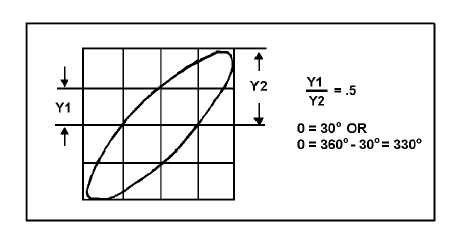1-128
Figure 1-38.—Computation of phase angle.
To find the angle, we should first divide Y1 by Y2. We can then take that number, look it up in the
sine portion of table 1-35, and read the angle.
For example, let's let each graticule in figure 1-36 represent 1 centimeter. Then,
If we look for .5 in the sine column of table 1-35, we find that .5 is the value for the sine of 30
degrees.
The frequency ratio between two sine waves can also be determined from lissajous patterns. Figure
1-39 shows various frequency ratios between signals. Figure 1-40 and 1-41, views A, show how phase
relationship can affect these patterns. If tangent lines are drawn across the top and down the side of the
pattern, the ratio of points (free ends and loops) that touch these lines equals the frequency ratio. Figure 1-
41 is an example of this method. Refer back to figure 1-39 and notice the relationship of loops and open
ends in each example. You can find more detailed information on lissajous patterns in the Electronics
Installation and Maintenance Book (EIMB), Test Methods and Practices, NAVSEA 0976-LP-000-0130.



